Royal Oak tube station
Royal Oak is a station of the London Underground, on the Hammersmith & City and Circle lines, between Westbourne Park and Paddington stations.[3] The station is on Lord Hill's Bridge and is in Travelcard Zone 2 for the London Underground. Although not heavily used at other times, the station is extremely busy during the annual Notting Hill Carnival. There is no wheelchair access to the platform. It is classed as a "local station" in Transport for London's "Fit for the Future" development outline.[4]
| Royal Oak | |
|---|---|
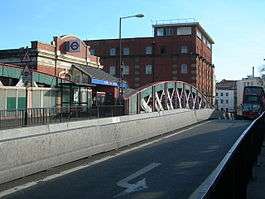 | |
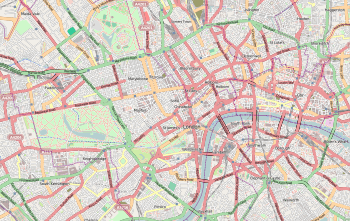 Royal Oak Location of Royal Oak in Central London | |
| Location | Westbourne Green |
| Local authority | City of Westminster |
| Managed by | London Underground |
| Number of platforms | 2 |
| Fare zone | 2 |
| London Underground annual entry and exit | |
| 2014 | |
| 2015 | |
| 2016 | |
| 2017 | |
| 2018 | |
| Key dates | |
| 1871 | Opened (GWR & H&C) |
| 1934 | Ended (GWR) |
| 1970 | Transferred to London Transport |
| 2009 | Started (Circle line) |
| Other information | |
| External links | |
| WGS84 | 51.519167°N 0.188056°W |
The station opened on 30 October 1871,[5] although the Metropolitan Railway extension to Hammersmith had opened in 1864. It is close to the elevated Westway section of the A40 road. The station is named after a nearby public house, "The Royal Oak"[6] (later "The Railway Tap" and now "The Porchester").
History
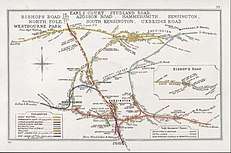
The station
When the Great Western Railway (GWR) main line was first opened in June 1838, the first stop out of Paddington was at West Drayton,[7] 13 miles 18 chains (21.28 km) from Paddington.[8] Intermediate stations were opened over the years, and the first stop became progressively closer to Paddington: a station at Ealing Broadway (5 miles 58 chains (9.21 km) from Paddington)[9] was opened in December 1838,[10] and one at Acton Main Line (4 miles 19 chains (6.82 km) from Paddington)[11] in 1868.[10] In the meantime, the Hammersmith and City Railway had opened from Green Lane Junction (near the present Westbourne Park) to Hammersmith on 13 June 1864, with the first stop on that route originally at Ladbroke Grove,[12] 1 mile 61 chains (2.84 km) out,[13] although one opened at Westbourne Park (1 mile 22 chains (2.05 km) out)[14] in 1866.[15][16]
An agreement between the GWR and the Metropolitan Railway (who had co-owned the Hammersmith & City with the GWR since 1867)[17] came into force on 1 July 1868, although it did not become legal until the following year. Under the agreement, various improvements were to be made; these included the provision of a station at Royal Oak, and the reconstruction of Westbourne Park.[18] On 30 October 1871 the station at Royal Oak opened,[5][16][19] 53 chains (1.07 km) out;[13] it was situated between Ranelagh Bridge and Lord Hills Bridge, and access was from the latter.[20] As originally built, it had three platform faces; one for down trains and two, each side of an island, for up trains.[20] It was served by both main line and Hammersmith & City trains, and, for over sixty years, this was the first stop out of Paddington for main line trains; it remains the first stop for Hammersmith & City services.
During the quadrupling of the Great Western Main Line (GWML) in 1878, a dive-under, known as Subway Tunnel, was constructed between Royal Oak and Westbourne Park. This was for Hammersmith & City services, allowing them to cross the main line without interfering with the flow of traffic; it was brought into use on 12 May 1878.[16] To accommodate the additional track of the main line, it was necessary to reduce Royal Oak station to two platform faces; the former down platform was removed (its track becoming the up main), and the southern of the two former up platforms became the down platform.[21]
Trains along the GWML ceased to call at Royal Oak from 1 October 1934,[22] but the Hammersmith & City service remained.[23] Ownership of the station was not transferred to London Transport until 1 January 1970.[24] The first GWML stop out of Paddington is now Acton Main Line.
Ranelagh Bridge depot
There had been a locomotive depot at Westbourne Park since 1855, which was replaced by the Old Oak Common depot in 1906.[25] To avoid the need for locomotives to make the 6-mile (9.7 km) round trip from Paddington just to be turned, coaled and watered, a small maintenance facility for locomotives was constructed on the southern side of the line, directly opposite Royal Oak station, which occupied part of the site of Westbourne Lodge and its grounds. It was known as Ranelagh Bridge depot, and opened in 1907.[26] There was a turntable, a water tower, a coaling stage and sidings where about 15 locomotives could be held awaiting their next trip west.[27] The turntable was removed in April 1964, and the depot facilities were altered to suit Diesel locomotives; the depot closed in 1980.[28]
Coach Station Proposal
At the end of 2018 residents became aware that Royal Oak was under consideration as a possible location for a new coach station to replace Victoria Coach Station. This was strongly opposed by Westminster's main political parties,[29][30][31] given the limited capacity of Royal Oak tube station and other local transport links, and the predominantly residential nature of the area. No firm details were published by Transport for London, but opponents of the scheme claimed that Royal Oak was the preferred site, that the scheme would occupy a 10,000 sq m site stretching from Lord's Hill Bridge (Royal Oak) to Westbourne Terrace, that a road bridge crossing the area would be closed and removed, and (in letters sent to local residents) that the tube station would have to be closed for an extended period while construction was in progress, since the coach station proposal included step-free access to the platform.[32] On 13 March 2019 the Mayor of London informed local groups that use of the site had been considered but it was not a viable site for this purpose and TfL would not take their plans forward.[33]
In popular culture
- The station appears in the 2006 film Kidulthood.
- Lord Hills Bridge is mentioned in the song "Nature Springs" on the album The Good, the Bad & the Queen.
- Royal Oak is mentioned in Peter Ackroyd's 1987 novel Chatterton (Part I, Chapter 4)
Connections
London Buses routes 18 and 36 and night bus route N18 serve the station.
Gallery
 Platform of the Royal Oak tube station looking westbound
Platform of the Royal Oak tube station looking westbound Platform eastbound towards Paddington main line station. Note the six numbered approach lines
Platform eastbound towards Paddington main line station. Note the six numbered approach lines Construction equipment for the Royal Oak Crossrail Portal, looking East along the eastbound platform, 2010
Construction equipment for the Royal Oak Crossrail Portal, looking East along the eastbound platform, 2010- Construction equipment for the Royal Oak Crossrail Portal, looking West under Lord Hill's bridge from the eastbound platform, 2010
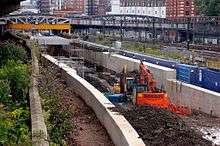 Construction of the Crossrail Portal at Royal Oak, seen from a footbridge to the west of Royal Oak Station, July 2011
Construction of the Crossrail Portal at Royal Oak, seen from a footbridge to the west of Royal Oak Station, July 2011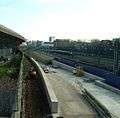 A later view from the same position, February 2012
A later view from the same position, February 2012 Construction equipment west of the footbridge, February 2012.
Construction equipment west of the footbridge, February 2012. The second Tunnel Boring Machine "Ada" en route to the Royal Oak Portal, June 2012
The second Tunnel Boring Machine "Ada" en route to the Royal Oak Portal, June 2012- Conveyor belt system for soil from tunnels, from station platform, August 2012
- Conveyor belt system for soil from tunnels, from Lord Hill's Bridge, September 2012
- The station platform from Lord Hill's Bridge, April 2013
- The Crossrail portal after completion of tunnelling, September 2014
Notes and references
Notes
- "Multi-year station entry-and-exit figures (2007-2017)" (XLSX). London Underground station passenger usage data. Transport for London. January 2018. Retrieved 22 July 2018.
- "Station Usage Data" (CSV). Usage Statistics for London Stations, 2018. Transport for London. 21 August 2019. Retrieved 27 April 2020.
- Baker 2007, p. 21, section B1
- "Fit for the Future: Future Stations". Transport for London. Retrieved 13 May 2015.
- Butt 1995, p. 200
- Harris 2006, p. 60
- MacDermot 1927, p. 55
- Peacock 1970, p. 105
- Peacock 1970, p. 101
- MacDermot 1927, p. 57
- Peacock 1970, p. 100
- MacDermot 1931, pp. 7,628
- Peacock 1970, p. 103
- Peacock 1970, p. 104
- Mitchell & Smith 2000, Figure 63
- Croome 2003, p. 17
- MacDermot 1931, p. 7
- Peacock 1970, p. 38
- Mitchell & Smith 2000, Figure 48
- Mitchell & Smith 2002, Figure IX
- Peacock 1970, p. 67
- Mitchell & Smith 2000, Figure 52
- Peacock 1970, p. 15
- Mitchell & Smith 2000, Figure 56
- Lyons 1974, p. 56
- Mitchell & Smith 2000, Figure 45
- Mitchell & Smith 2000, Figure 46
- Mitchell & Smith 2000, Figure 47
- "Save Bayswater Village - Stop the Royal Oak Coach Station". Westminster Conservatives. Retrieved 17 December 2018.
- "Westminster Labour calls for Royal Oak Coach Station option to be taken off the table in favour of Heathrow and East London alternatives". Westminster Labour. Retrieved 17 December 2018.
- "Campaigners battle transport chiefs over £350m plan to move Victoria Coach Station". Evening Standard. 31 January 2019. Retrieved 11 March 2019.
- "Proposed Coach Station and skyscraper will adversely affect local people in Little Venice". Proposed Coach Station and skyscraper will adversely affect local people in Little Venice. Westminster Conservatives. Retrieved 2 March 2019.
- Khan, Sadiq. "Letter from the Mayor of London" (PDF). Westminster Labour Party.
References
- Baker, S. K. (April 2007) [1977]. Rail Atlas Great Britain & Ireland (11th ed.). Hersham: Oxford Publishing Co. ISBN 978-0-86093-602-2. 0704/K.CS1 maint: ref=harv (link)
- Butt, R. V. J. (1995). The Directory of Railway Stations. Yeovil: Patrick Stephens Ltd. ISBN 1-85260-508-1. R508.CS1 maint: ref=harv (link)
- Croome, Desmond F. (2003). The Circle Line: An Illustrated History. Harrow Weald: Capital Transport. ISBN 1-85414-267-4.CS1 maint: ref=harv (link)
- Harris, Cyril M. (2006) [1977]. What's in a name? (4th ed.). Harrow Weald: Capital Transport. ISBN 1-85414-241-0.CS1 maint: ref=harv (link)
- Lyons, E. T. (1974) [1972]. An Historical Survey of Great Western Engine Sheds 1947. Headington: Oxford Publishing Co. ISBN 0-902888-16-1.CS1 maint: ref=harv (link)
- MacDermot, E. T. (1927). History of the Great Western Railway, vol. I: 1833–1863. Paddington: Great Western Railway.CS1 maint: ref=harv (link)
- MacDermot, E. T. (1931). History of the Great Western Railway, vol. II: 1863–1921. Paddington: Great Western Railway.CS1 maint: ref=harv (link)
- Mitchell, Vic; Smith, Keith (January 2000). Paddington to Ealing. Western Main Lines. Midhurst: Middleton Press. ISBN 1-901706-37-0.CS1 maint: ref=harv (link)
- Mitchell, Vic; Smith, Keith (April 2002). Paddington to Princes Risborough. Western Main Lines. Midhurst: Middleton Press. ISBN 1-901706-81-8.CS1 maint: ref=harv (link)
- Peacock, Thomas B. (1970) [1968]. Great Western London Suburban Services. Locomotion Papers (2nd ed.). Oakwood Press. LP48.CS1 maint: ref=harv (link)
External links
| Wikimedia Commons has media related to Royal Oak tube station. |
- "Photographic Archive". London Transport Museum. Archived from the original on 18 March 2008.
| Preceding station | Following station | |||
|---|---|---|---|---|
towards Hammersmith | Circle line | |||
| Hammersmith & City line | towards Barking |
|||
| Historical railways | ||||
| Preceding station | Following station | |||
towards Hammersmith | Metropolitan line Hammersmith branch (1864–1990) | towards Paddington |
||
| Preceding station | Following station | |||
| Westbourne Park Line and station open |
Great Western Railway Great Western Main Line |
London Paddington Line and station open | ||